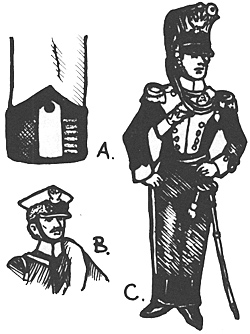 Since writing the articles that appeared in MWAN #120, I have found some better information on the uniforms of the Hungarian Army, which means there are some additions and changes to the uniform information. In addition, several folks have commented on the "obscure" nature of the Hungarian War of Independence, despite the size of the conflict. It is obscure today partly because of the concerted efforts of the Austrians to suppress any information after the war. It was even a crime to mention the Hungarian War in conversation for many years afterward. However, for the Europeans, the war and its aftermath reverberated in European and American politics for decades. Almost twenty years later the same Austrian Emperor that labeled the Hungarian Constitution 'treasonous' in 1848 agreed to it in full in 1867, creating the Austrian Empire and Hungarian Kingdom. The Honved Army fought along side the Austrian Army in World War I.
Since writing the articles that appeared in MWAN #120, I have found some better information on the uniforms of the Hungarian Army, which means there are some additions and changes to the uniform information. In addition, several folks have commented on the "obscure" nature of the Hungarian War of Independence, despite the size of the conflict. It is obscure today partly because of the concerted efforts of the Austrians to suppress any information after the war. It was even a crime to mention the Hungarian War in conversation for many years afterward. However, for the Europeans, the war and its aftermath reverberated in European and American politics for decades. Almost twenty years later the same Austrian Emperor that labeled the Hungarian Constitution 'treasonous' in 1848 agreed to it in full in 1867, creating the Austrian Empire and Hungarian Kingdom. The Honved Army fought along side the Austrian Army in World War I.
Uniform Addendums
1. Both Austrian and Hungarian regulars had a white lace stripe with buttons on the outside of each cuff. It was parallel with the sleeve. Picture A
2. The Hungarian National Guard in general was dressed as represented by the 33rd Honved Battalion picture 9b in MWAN #120. The cording on the coat was black instead of red, and all belting was black leather. The helmet shown for the National Guard was only seen a little. It seems that old Austrian shakos were much more plentiful, besides, felt and leather shakos were easier to make than helmets.
3. The Hungarian Hussars all had red cording on their uniform. The red, white and green cording was reserved for the shako cording and officers sashes. Only the 17th Hussars were different, having white cording. The 12 regular Hussar regiments changed their cording from the Austrian yellow and black to red during the war.
4. All backpacks were brown and fur-covered.
5. The Polish Legion had a red base to their caps from the fur to the square top. The front plate was a large white metal Polish eagle. Picture B
6. The Polish Lancer shown in MWAN #120 was a volunteer force of two squadrons, later incorporated into the Polish 2nd Lancer Regiment. Several squadrons of the Austrian 2nd Uhlans also joined the Hungarians. They kept their Austrian uniforms, but the lance pennant was a swallow-tailed tri-color and piping was changed from yellow to red. There were actually three regiments of Lancers, not two. The Polish lancers had a dark blue uniform identical in cut to the Austrian Uhlan uniform, but the facings were light blue for the 1st, yellow for the 2nd, and white for the 3rd regiment, including the color of the capska top. Picture C. The capska had a large white metal eagle on the front like the Polish infantry legions. All lance pennants were swallowtailed, dark blue on top, facing color on the bottom for the first two regiments, white over red for the third. Epaulettes were light blue for the first regiment and white for the other two. Buttons were white metal.
Some folks have wondered how prevalent the actual uniforms were, considering that this was a rebellion that lasted little over fifteen months. The Hungarian efforts to clothe and arm their armies were nothing less than amazing. By October of 1848, the Hungarians were producing 500 muskets and 10 cannon a week. (This is the same numbers that France was producing in 1793 with a population five times that of the Hungarians.) Hungary was the textile center for the Austrian Empire. Kossuth made use of this by having the uniforms cut out in mass and sent to the hundreds of cottage industries around the country to be dyed and sown together. That way when the uniforms were made, they could be immediately given to the local armed forces and newly recruited soldiers from the same area. Even the battle flags were made in mass, over one hundred were created in October to December of 1848, ready to be given to newly raised battalions in the coming months.
Most of the Honved soldiers surrendered in August of 1849 in new regulation uniforms. A shortage of gunpowder and a makeshift supply system were really the only things that the Hungarians struggled with. While there were a variety of uniforms, Hungarian Honved units were all in uniform.
Back to MWAN # 123 Table of Contents
Back to MWAN List of Issues
Back to MagWeb Magazine List
© Copyright 2003 Hal Thinglum
This article appears in MagWeb.com (Magazine Web) on the Internet World Wide Web.
Other articles from military history and related magazines are available at http://www.magweb.com